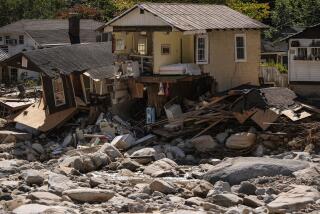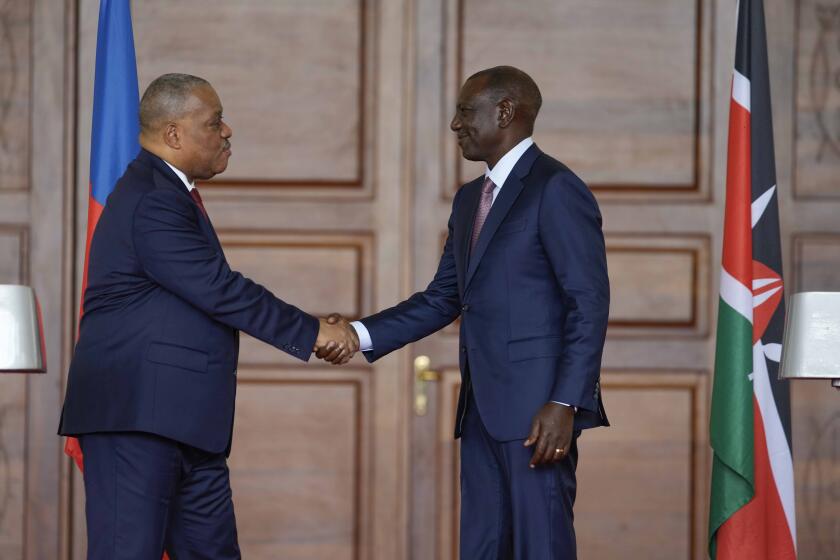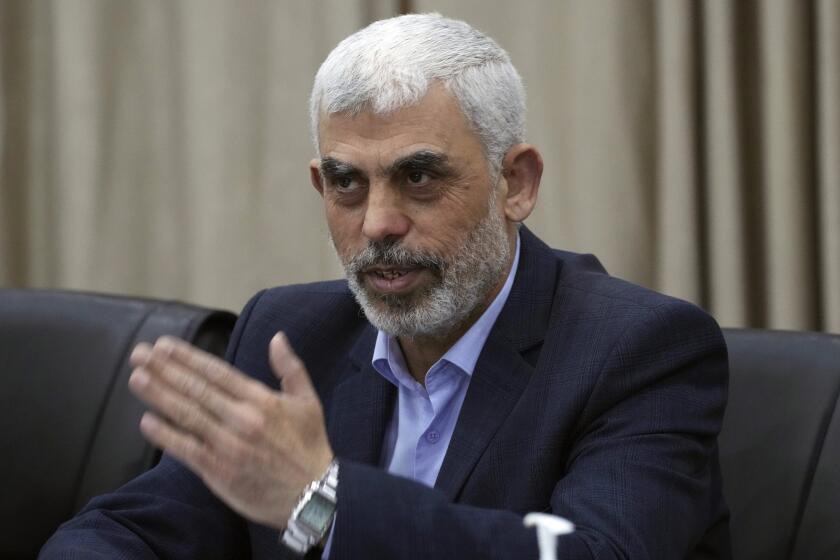COLUMN ONE : Debris of War: Death Underfoot : With the threat from weapons of mass destruction diminished, land mines are seen as an instrument of terror, killing and maiming thousands of innocent civilians every year.
When she was 25 years old, Yourse Pisei was walking along a footpath to a market in northwestern Cambodia when suddenly she heard a deafening explosion and was knocked over. Stunned by pain, Yourse looked down her leg and realized her foot was gone.
“I was so scared,” she recalled months later. “I knew a lot of people who had lost a leg or a foot. But I never thought it would happen to me. I was just so afraid.”
Yourse is one of the estimated 36,000 people in Cambodia who have been disabled by land mines. Although the war here officially ended in October, 1991, there are still an estimated 4 million mines scattered over western Cambodia, and doctors say that, even now, 200 new amputees are created each month. Cambodia has more disabled people, on a per capita basis, than any other nation in the world.
In the post-Cold War age, when the threat of weapons of mass destruction such as chemical and biological weapons appears to have diminished, land mines are increasingly recognized as an international scourge, killing and maiming thousands of innocent civilians every year.
There are an estimated 80 million mines in place around the world. Afghanistan is probably the worst, littered with an estimated 10 million Soviet mines of every description. But the devices are also creating huge numbers of casualties in Cambodia, Somalia, Mozambique, Angola and the Balkans.
The mines go on killing long after the soldiers have finished fighting. The first American killed in Somalia last year died when his vehicle hit a mine left behind from the country’s years of civil war.
In an effort to control the spreading damage from mines, international conferences have been organized this year with a view toward imposing limits on use of the devices or even banning them outright. The biggest event, hosted by the International Committee of the Red Cross, opened Wednesday in Montreux, Switzerland.
One reason the Red Cross has gotten involved is the traditional Swiss connection with the Geneva conventions, which specify what activities are legal conduct in warfare. The other reason is that Red Cross doctors sent to crisis spots are increasingly finding themselves forced into performing traumatic amputations on mine victims.
“Land mines are a pretty malignant weapon in that they will devastate a country and prevent rehabilitation after an armed conflict,” said Robin Copeland, a British surgeon who works for the agency. “Warfare of this sort, where mines are left after a conflict without marked minefields is, to me, as a physician, an unacceptable way to wage war.”
Last year, the U.S. Congress adopted a one-year moratorium on the export of American mines, a largely symbolic step since the United States accounted for only $980,000 in sales over the past decade, according to Sen. Patrick J. Leahy (D-Vt.), who sponsored the legislation. About 35 other countries are major mine exporters.
“Land mines have become an incredible problem in terms of military pollution,” said Robert O. Muller, executive director of the Vietnam Veterans of America Fund, a key lobbyist behind the adoption of the American moratorium. “The numbers are staggering and it’s a problem that’s not going to go away.”
Poland offers an example of how long mines can linger to wound a nation. It was heavily mined by the Germans and Soviets in World War II. As late as the 1970s, despite having access to Warsaw Pact detection technology, hundreds of people were injured by undiscovered mines.
Modern technology has added technical wizardry to the simple mine. The devices have been around since World War I, when they were developed as a response to the newly invented tank. Mines now jump out of the ground or go off when a victim merely passes nearby, rather than actually having stepped on them. Mines are planted with booby traps to prevent their removal or dropped from airplanes to saturate a wide area. One mine looks like a plastic butterfly, and children love to play with them--with disastrous consequences.
Recent innovations in China and Pakistan have produced a virtually metal-free mine that cannot be detected with conventional equipment.
Mines usually fall into one of two categories: They are aimed at vehicles, such as tanks, or they are directed against people. Anti-personnel mines have a particularly gruesome role--they are primarily designed to maim rather than kill so that an enemy is burdened with wounded who need care, sapping the unit’s ability to fight.
“The problem is that there still is a definite requirement for mines in the military world,” said Colin Mitchell, a famed former British army colonel who set up a charity called the Halo Trust in 1986 to remove mines around the world.
“A land mine is a very cheap soldier. You don’t pay him, just put him on parade and leave him as sentry and go away. If you are defending an area, you need mines for all sorts of reasons.”
The problems really begin after the military conflict is finished. Warring soldiers leave behind fields of mines just as a civilian population arrives to return to normal life. The results can be catastrophic.
“Everybody is the loser,” said Muller. “Whoever winds up on top at the end of the conflict has a country that is un-rehabitable because of these mines.”
After the end of the Afghan war last year, thousands of refugees have attempted to move back to their old homes. But they are returning to a country that in some areas is carpeted with mines left by Soviet soldiers to protect key highways and installations; the Afghans, who fled as refugees, have no idea where the mines are.
Typically, doctors say, those lucky enough to survive a mine blast require four separate surgeries, lasting from a few minutes to hours, as surgeons pick fragments and dirt out of a devastated limb.
“There’s also a psychological trauma,” said Copeland, who has performed hundreds of amputations at hospitals in Cambodia and Afghanistan. “Many victims suffer what can only be described as grief reaction at the loss of their limb.”
Making matters worse, in many countries of Asia and Africa, an amputee is automatically condemned to a life as a beggar, too poor to afford a prosthetic limb and unable to raise crops or support a family.
“There is a very strong feeling against amputees in Cambodia,” said Benoit Denise, who works for the French charity Handicap International in Phnom Penh. “You might think people who gave their leg for their country might gain some respect. But on the contrary. People believe they have bad karma. They are told they are worthless. Often a wife or husband will desert them.”
When President Francois Mitterrand toured Cambodia in February, he was so moved by the sight of amputees that he called for a European ban on trade in mines for five years. If adopted, the ban could be particularly effective because three Italian firms are reportedly the world’s largest exporters of mines.
Efforts to control mine use began in 1981, when an international convention was adopted on conventional weapons deemed to have “indiscriminate effects.” Protocol II of the convention banned mine use in towns and villages where there is no conventional fighting and requires warring nations to record the location of all minefields.
The problem with the convention is that it has been signed by just 53 nations. The United States signed but never got around to ratifying the pact because the Ronald Reagan and George Bush administrations refused to submit it to Congress in a dispute over another convention.
Experts say another severe drawback to the existing convention is that it legally applies only to nations at war, not to groups involved in civil conflict. In recent years, those conflicts--in Cambodia, Afghanistan, Angola and Somalia--have been as a bloody as most full-fledged wars.
The Vietnam Veterans are organizing a conference in London in May designed to begin the process of amending the Land Mine Protocol when it reaches its 10th anniversary in December. Since the United States has not ratified the pact, France has agreed to call for negotiations on a new protocol.
One suggestion is to require that all mines have a deactivation circuit, which would make them harmless after time; another would require self-destruct mechanisms.
But even a total ban, if it could be adopted, would prove little benefit to countries already blighted by millions of mines put in place over the last 20 years. Remarkably, while there are international groups devoted to everything from satellites to the study of malaria, no international body has been set up to remove the debris of war.
In Cambodia, for example, only one of more than 30 military contingents present for the current preliminaries to multi-party elections--troops from France--is actually removing mines. Elsewhere in the world, the work is left to local forces or charities such as Britain’s Halo Trust or Mine Action Group, both largely made up of army veterans trained as sappers--soldiers who place mines.
“Everyone keeps talking about it and writing papers and having conferences, but where the real edge is needed is getting the mines out of the ground now, today, because by tomorrow morning, if you don’t, someone is going to lose a hand or a foot,” said the Halo Trust’s Colin Mitchell.
His group has just 21 volunteer expatriates training and supervising mine-clearance teams in Cambodia, Afghanistan and now Mozambique. In the last 13 months, the group has suffered nine casualties; two of the dead were former British army mine-clearance experts.
In fact, Paul Jefferson--Halo’s star mine-clearing expert--went to Kuwait to help there after the Iraqi invasion. Hired at a hefty salary by British Ordnance, a private firm, Jefferson returned home after only two weeks with one leg missing and blind in both eyes.
“It’s incredibly dangerous work,” Mitchell said. “It has to be done by hand, the same way I did it in Italy in 1944, on your hands and knees with a bayonet probing for mines.”
Mechanical clearance of mines is still not practical because bulldozers and “flails,” devices that beat the ground, cannot give complete assurance that all mines have been removed.
As an indicator of how painstaking the process is, Lt. Col. Alan Roland-Price, a British officer who formerly headed the Cambodia Mines Action Committee, reported that in a recent six-month period, all the mine-clearing by the United Nations and charity groups removed just 7,147 anti-personnel mines and 12 anti-tank mines. There were nine casualties, four involving supervising U.N. soldiers.
Meantime, the minimum estimate for the number of mines in Cambodia is 4 million; some estimates range as high as 10 million. And the war is not over--new mines are still being laid, particularly by the Khmer Rouge, the Maoist guerrillas who have refused to take part in next month’s elections.
“There’s an awful lot of minefields left, even some we don’t know about,” said Roland-Price. “There’s going to be a lot of work for a lot of years to come.”
More to Read
Sign up for Essential California
The most important California stories and recommendations in your inbox every morning.
You may occasionally receive promotional content from the Los Angeles Times.










